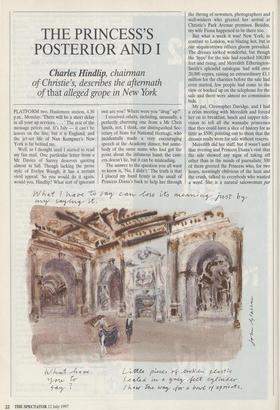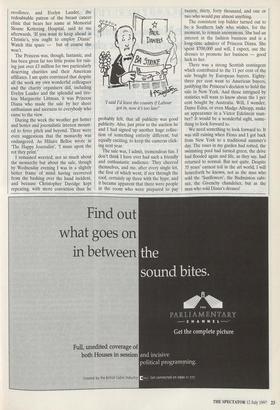THE PRINCESS'S POSTERIOR AND I
Charles Hindlip, chairman of Christie's, describes the aftermath of that alleged grope in New York PLATFORM two, Haslemere station, 4.30 p.m., Monday. 'There will be a short delay in all your up services. . . . ' The rest of the message peters out. It's July — it can't be leaves on the line, but it is England, and the jet-set life of Nan Kempner's New York is far behind me.
Well, so I thought until I started to read my fan mail. One particular letter from a Mr Davies of Surrey deserves quoting almost in full. Though lacking the prose style of Evelyn Waugh, it has a certain vivid appeal: 'So you would do it again, would you, Hindlip? What sort of ignorant twit are you? Where were you "drug" up?'
I received others, including, unusually, a perfectly charming one from a Mr Chris Smith, not, I think, our distinguished Sec- retary of State for National Heritage, who incidentally made a very encouraging speech at the Academy dinner, but some- body of the same name who had got the point about the infamous hand: the cam- era doesn't lie, but it can be misleading.
The answer to the question you all want to know is, 'No, I didn't.' The truth is that I placed my hand firmly in the small of Princess Diana's back to help her through the throng of newsmen, photographers and well-wishers who greeted her arrival at Christie's Park Avenue premises. Besides, my wife Fiona happened to be there too.
But what a week it was! New York, in contrast to London, was blazing hot, but in our sequin-strewn offices gloom prevailed. The dresses looked wonderful, but though the 'hype' for the sale had reached 100,000 feet and rising, and Meredith Etherington- Smith's splendid catalogue had sold over 20,000 copies, raising an extraordinary £1.1 million for the charities before the sale had even started, few people had come to the view or hooked up on the telephone for the sale and there were almost no commission bids.
My pal, Christopher Davidge, and I had a crisis meeting with Meredith and forced her on to breakfast, lunch and supper tele- vision to tell all the wannabe princesses that they could have a slice of history for as little as $500, pointing out to them that the dresses really were for sale without reserve.
Meredith did her stuff, but it wasn't until that evening and Princess Diana's visit that the sale showed any signs of taking off other than in the minds of journalists; 500 of them greeted the Princess who, for two hours, seemingly oblivious of the heat and the crush, talked to everybody who wanted a word. She is a natural saleswoman par excellence, and Evelyn Lauder, the redoubtable patron of the breast cancer clinic that bears her name at Memorial Sloane Kettering Hospital, said to me afterwards, 'If you want to keep ahead in Christie's, you ought to employ Diana!' Watch this space — but of course she won't.
The Princess was, though, fantastic, and has been given far too little praise for rais- ing just over £3 million for two particularly deserving charities and their American affiliates. I am quite convinced that despite all the work my own wonderful colleagues and the charity organisers did, including Evelyn Lauder and the splendid and tire- less Marguerite Littman, it was Princess Diana who made the sale by her sheer enthusiasm and niceness to everybody who came to the view.
During the week the weather got hotter and hotter and journalistic interest mount- ed to fever pitch and beyond. There were even suggestions that the monarchy was endangered. As Hilaire Belloc wrote in `The Happy Journalist', 'I muse upon the rot they print.'
I remained worried, not so much about the monarchy but about the sale, though by Wednesday evening I was in a slightly better frame of mind having recovered from the bashing over the hand incident, and because Christopher Davidge kept repeating, with more conviction than he `I said I'd leave the country if Labour got in, now it's too late!'
probably felt, that all publicity was good publicity. Also, just prior to the auction he and I had signed up another huge collec- tion of something entirely different, but equally exciting, to keep the cameras click- ing next year.
The sale was, I admit, tremendous fun. I don't think I have ever had such a friendly and enthusiastic audience. They cheered themselves, and me, after every single lot, the first of which went, if not through the roof, certainly up there with the hype, and it became apparent that there were people in the room who were prepared to pay twenty, thirty, forty thousand, and one or two who would pay almost anything.
The consistent top bidder turned out to be a Southern lady who wishes, for the moment, to remain anonymous. She had an interest in the fashion business and is a long-time admirer of Princess Diana. She spent $700,000 and will, I expect, use the dresses to promote her business — good luck to her.
There was a strong Scottish contingent which contributed to the 11 per cent of the sale bought by European buyers. Eighty- three per cent went to American buyers, justifying the Princess's decision to hold the sale in New York. And those intrigued by statistics will want to know about the 1 per cent bought by Australia. Will, I wonder, Dame Edna, or even Madge Allsopp, make an appearance in a Victor Edelstein num- ber? It would be a wonderful sight, some- thing to look forward to.
We need something to look forward to. It was still raining when Fiona and I got back from New York to a traditional summer's day. The roses in my garden had rotted, the swimming pool had turned green, the drive had flooded again and life, as they say, had returned to normal. But not quite. Despite 35 years' earnest toil in the art world, I will henceforth be known, not as the man who sold the 'Sunflowers', the Badminton cabi- net, the Givenchy chandelier, but as the man who sold Diana's dresses!



























































 Previous page
Previous page